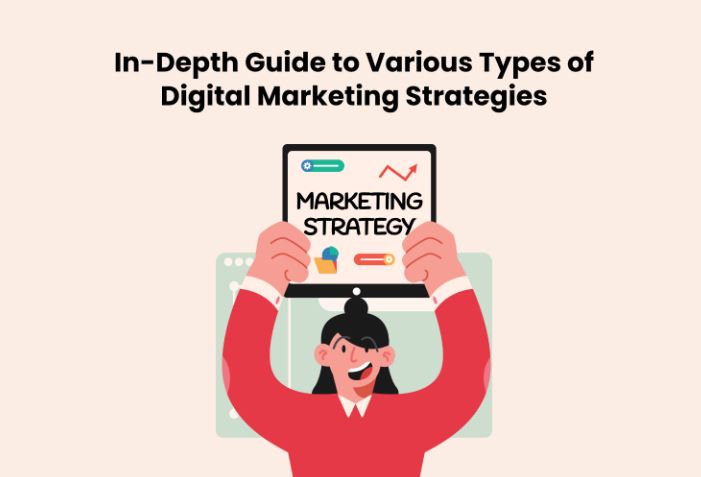Digital marketing has emerged as the default mode of marketing for driving brand visibility, engagement, and conversions in the online sphere. Understanding the multitude of strategies encompassed within Digital Marketing is crucial for businesses aiming to thrive in the digital realm. This comprehensive guide delves into the various Types of Digital Marketing strategies that empower brands to establish a formidable online presence, engage audiences, and drive sustainable growth.
Search Engine Optimisation (SEO)
Search Engine Optimisation, or SEO, is the most important part of digital marketing. It includes many techniques that can help a website appear higher on search engine results pages (SERPs). Off-page SEO is about building links and credibility through external mentions, while on-page SEO is about optimising content, meta tags, and site layout.
Technical SEO ensures that search engine bots can easily crawl and process a website. This includes things like how the site is structured and how well it works on mobile devices. Local SEO focuses on specific areas by improving Google My Business listings and local searches.
Voice search optimisation, which changes content for conversational questions and long-tail keywords to work with voice-enabled devices, has also become more important. For long-term SEO success, you must keep an eye on things, adjust to search engine algorithm changes, and stick to best practices.
SEO is essential for companies that want to be seen online and get relevant website visitors because it builds the foundation for organic traffic generation.
Content Marketing
material marketing is an important part of digital marketing. It involves making useful, consistent, and relevant material to your audience to engage and connect with them. It goes beyond traditional advertising by focusing on meeting people’s wants for information, entertainment, or solutions. Blogs, videos, infographics, podcasts, eBooks, and social media posts are just some of the different types of content that are used carefully to keep people interested across all platforms.
Content marketing is all about sharing stories and getting to know your customers. When brands handle their customers’ problems, answer their questions, or make them feel welcome, they build credibility, trust, and loyalty. Every single piece of content is carefully made to fit with the brand’s voice, beliefs, and goals while also being useful or fun for the readers.
A good content marketing plan not only brings in visitors but also keeps leads interested, encourages people to support your brand, and finally, turns visitors into buyers. Metrics like engagement, shares, and conversions help improve content tactics, so they stay relevant and effective with the target audience.
Social Media Marketing
Social media sites have changed the way brands connect with their customers because they are so popular. Using sites like Facebook, Instagram, Twitter, LinkedIn, and TikTok for social media marketing helps spread the word about a brand, get people interested in it, and sell goods or services. Key parts of a good social media strategy are creating interesting content, running targeted ads, and getting people in the community to interact with each other.
Pay-Per-Click Advertising (PPC)
Businesses can get instant website traffic through pay-per-click (PPC) advertising, which involves paying for ad space on search engines and other sites. Marketers can bid on keywords or demographics on Google Ads and social media advertising platforms to ensure their ads appear high for people looking for related goods or services.
Email Marketing
Even though there are newer strategies, email marketing is still a powerful way to keep leads interested and build relationships with customers. Businesses can send relevant material, promotions, and updates directly to their subscribers by sending personalised, targeted emails to groups of people. This leads to more engagement and sales.
Influencer Marketing
In the past few years, working with influencers or people who have a large online following has become very popular. Influencer marketing is when you work with these people to get their engaged audience to buy your goods or use your services. Brands can get more attention and connect with niche groups by using their reputation and reach to their advantage.
Affiliate Marketing
Partnering with affiliates who promote a business’s goods or services in exchange for a commission is part of this performance-based marketing approach. Affiliates use unique links or codes to keep track of the purchases of people they refer. This is a cheap way for brands to reach more people and make more sales across multiple online channels.
Video Marketing
Video marketing is now an important part of digital plans because the number of people watching videos is growing exponentially. Businesses can make videos that people want to watch on sites like YouTube, Instagram, and TikTok. These videos can tell stories, show off products, give instructions, or tell a brand’s story.
Mobile Marketing
Mobile marketing tactics use optimised websites, mobile apps, SMS marketing, and location-based services to reach people on their phones. This is because smartphones are so common. Making experiences mobile-friendly and using app-based promotions increase engagement and make it easier to connect with customers while they’re on the go.
Conclusion
Businesses need to use a variety of digital marketing tactics to stand out, connect with their audience, and get results that can be measured. Brands can make holistic, data-driven strategies that work with their target audience if they understand the differences and possibilities of each strategy. By always changing and combining these different strategies, companies can adapt to the constantly changing digital world and grow in the tough online arena.







